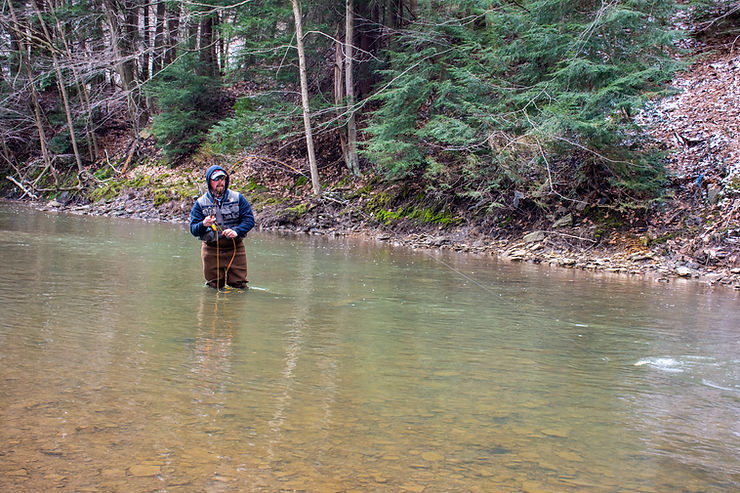Swinging Streamers and Wet Flies

The traditional way to fish streamers and wet flies, and perhaps most common, is to swing them. This is probably how they were originally meant to be fished and can produce results with minimal amounts of effort. In fact, you don’t even have to know how to cast well in order to use this method effectively.
Watch a group of minnows or other baitfish move about in a stream. They very rarely swim straight up or straight down in the current unless provoked. Rather, when moving downstream, in particular, they do so with their bodies turned at a 45 degree angle, noses pointing into the current. This is a controlled motion that allows them to seemingly glide to their next holding water. It’s also what triggers strikes from predatory fish.
To imitate this natural motion, stand at the head where faster water flows into a pool. Pull out enough line so that your leader connection clears your guides. Flick the leader and fly into the current and pull more line from your reel, allowing the current to carry your fly downstream.
Next, squeeze the line against the rod handle with your index finger. Lift the rod tip until the fly reaches the surface directly downstream. Using the tension of the water makes it easier to now flick the fly directly across stream or quartering upstream, similar to a slingshot.
As the fly floats downstream, it will sink. By the time it reaches the quartering downstream position, it has bottomed out and will begin rising again. During this ascension, similar to that of a baitfish moving up off the bottom and gliding downstream, is when most strikes occur. There are reasons for this.
First, in most streams and rivers, trout often feed on the bottom, nosing the substrate for nymphs, sculpins, and other food. They’re geared to look for food coming from below. It’s natural to them. This is also why swinging wet flies is so effective. When nymphs are ready to emerge, they swim up through the water column, and they’re vulnerable to trout.
Second, the angle at which the fly moves downstream provides a bigger target for predators. In some cases, it can signal a wounded baitfish, too, and an easy meal.
Most times, the fly will be floating horizontally in the current until it reaches the quartering downstream position. At that point, it will begin to straighten out, and the tail end will “kick” into position. It’s a subtle movement, but the world of trout is full of subtleties, and these often mean the difference between failure and success.
If you’ve ever used a spinner on spinning gear, you can probably attest to the effectiveness of the downstream swing, especially at that point where the tail end flutters. The same concept applies to swinging streamers. This motion triggers a strike response in every species by tapping into a basic behavior of most predators – they’re most interested in attacking prey that looks like it might get away. In this case, the “kick” is akin to a wounded baitfish righting itself again.
Once the streamer has arrived directly downstream, you can then strip it in all the way back to your position. At this point, I like to work the fly back upstream through the seam where faster and slower water meet and trout are likely to hold.

If you’re new to fly casting, I’d recommend stopping your retrieve while the line is still 15 feet or so downstream, before your leader connection reaches the guides and while you still have several feet of fly line in the water to help you cast again. At this point you can slingshot the line out across or quartering upstream, or if you need more distance, throw a little line out into the faster current first. This will wash the fly back out into the pool’s current and provide more tension for getting the line out a little farther without having to utilize a more technical roll cast. For advanced casters, this technique works well in tight cover.
Swinging streamers is done with both short or long lines. Generally speaking, I start with a short line, with the water closest to me, and gradually increase my range. Once I’ve identified the prime holding lies, I swing the streamer along the fringes first.
Occasionally you can pick up a fish or two from the fringes. If you plunge right into the best stuff, though, you might still get a couple, but in the process might spook a few others that you also could’ve had.
Depending on the mood of the fish, varying your retrieve can induce more strikes. Sometimes, as the fly reaches the quartering downstream position, I like to start stripping the line, just a few short, quick strips maybe four to six inches long. This will cause the fly to speed up, which can make trout strike impulsively rather than out of hunger. When fish are sluggish, or on highly pressured waters, this technique can be very effective.
I believe most fly fishermen fish too fast with streamers and wet flies. Slow things down, make sure your fly gets to the bottom, and then gradually bring it up through the water column. Also, there’s no rule about how many casts you have to make. Sometimes, if the fish are really sluggish, I’ll just let the fly hang directly downstream, twitching it here and there, allowing it to flutter in the current for several minutes before making another cast.
Sign up for the Dark Skies Fly Fishing e-newsletter
It's free, delivered to your inbox approximately three times each month. Your information is always kept private and used for the sole purpose of keeping you up to date on blog posts and specials in the online store.
Sign Up Now